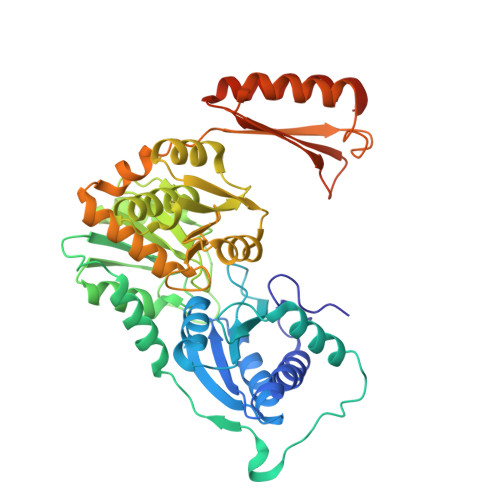Structural basis for the inhibition of the Bacillus subtilis c-di-AMP cyclase CdaA by the phosphoglucomutase GlmM.
Pathania, M., Tosi, T., Millership, C., Hoshiga, F., Morgan, R.M.L., Freemont, P.S., Grundling, A.(2021) J Biological Chem 297: 101317-101317
- PubMed: 34678313
- DOI: https://doi.org/10.1016/j.jbc.2021.101317
- Primary Citation of Related Structures:
7OJR, 7OJS, 7OLH, 7OML - PubMed Abstract:
Cyclic-di-adenosine monophosphate (c-di-AMP) is an important nucleotide signaling molecule that plays a key role in osmotic regulation in bacteria. c-di-AMP is produced from two molecules of ATP by proteins containing a diadenylate cyclase (DAC) domain. In Bacillus subtilis, the main c-di-AMP cyclase, CdaA, is a membrane-linked cyclase with an N-terminal transmembrane domain followed by the cytoplasmic DAC domain. As both high and low levels of c-di-AMP have a negative impact on bacterial growth, the cellular levels of this signaling nucleotide are tightly regulated. Here we investigated how the activity of the B. subtilis CdaA is regulated by the phosphoglucomutase GlmM, which has been shown to interact with the c-di-AMP cyclase. Using the soluble B. subtilis CdaA CD catalytic domain and purified full-length GlmM or the GlmM F369 variant lacking the C-terminal flexible domain 4, we show that the cyclase and phosphoglucomutase form a stable complex in vitro and that GlmM is a potent cyclase inhibitor. We determined the crystal structure of the individual B. subtilis CdaA CD and GlmM homodimers and of the CdaA CD :GlmM F369 complex. In the complex structure, a CdaA CD dimer is bound to a GlmM F369 dimer in such a manner that GlmM blocks the oligomerization of CdaA CD and formation of active head-to-head cyclase oligomers, thus suggesting a mechanism by which GlmM acts as a cyclase inhibitor. As the amino acids at the CdaA CD :GlmM interphase are conserved, we propose that the observed mechanism of inhibition of CdaA by GlmM may also be conserved among Firmicutes.
- Section of Molecular Microbiology and Medical Research Council Centre for Molecular Bacteriology and Infection, Imperial College London, London, United Kingdom.
Organizational Affiliation:

















